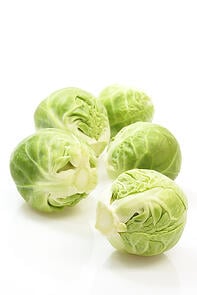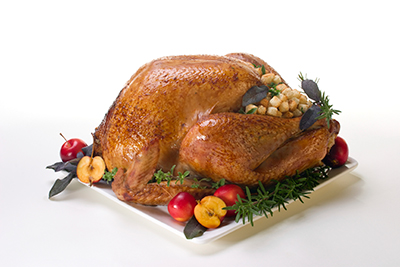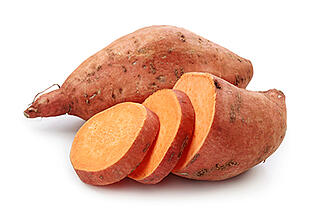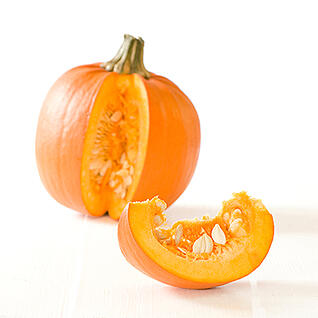Charter member Candy Lander talks about her favorite things about NIFS. Watch Video.
by Trudy Coler, on Nov 27, 2013 11:39:00 AM
Charter member Candy Lander talks about her favorite things about NIFS. Watch Video.
by Angie Scheetz, on Nov 26, 2013 1:08:00 PM
We have all heard about holiday weight gain from eating too much of those delicious celebratory foods. However, a lot of the foods that we typically only see around this time of  year can be very good for us. Here are some superfoods and recipes to incorporate into your annual holiday feasts!
year can be very good for us. Here are some superfoods and recipes to incorporate into your annual holiday feasts!
Brussels Sprouts:
Pomegranate:

Brussels Sprouts with Pomegranate and Bacon
Makes 3 to 4 side-dish servings
5 to 6 cups Brussels sprouts (about 1.5 lbs.), cleaned and quartered
2 slices turkey bacon or center-cut bacon, cut into small pieces
¼ cup pomegranate seeds
¼ cup pecan halves, roughly chopped
⅛ to ¼ tsp. sea salt and pepper, depending on preference
(Recipe from www.eatliverun.com.)
Turkey:
Turkey Pot Pie Soup
Makes 8 servings
¼ cup flour
2 cups turkey stock
4 cups fat-free milk
2 large celery stalks, chopped
1½ cups chopped onion
8 oz. sliced mushrooms
Fresh ground pepper
2 TB. chopped parsley
8 oz. frozen peas and carrots
1 tsp. turkey bouillon (or more to taste)
2 medium (12 oz. total) potatoes, peeled and cubed small
16 oz. cooked turkey breast, diced small or shredded
(Recipe from www.skinnytaste.com.)
Sweet Potatoes:
Sweet Potato Casserole
Makes 12 servings
1 lb. cooked, mashed sweet potato
½ cup orange juice
½ cup sugar
½ teaspoon vanilla
2 egg whites
Topping:
½ cup brown sugar
2 tablespoons flour
2 tablespoons butter
Pumpkin:
Cinnamon:
Pumpkin Pie Dip
Makes 12 servings
15 oz. canned pumpkin
8 oz. Cool-Whip
1 package sugar-free, fat-free vanilla pudding mix
½ TB. pumpkin pie seasoning
½ tsp. cinnamon
½ tsp. nutmeg
Sliced apples for dipping
Red Wine:
Pot Roast with Dried Fruit and Red Wine
Makes 6 servings
1 well-trimmed boneless beef rump roast (2 pounds), tied
¾ teaspoon salt
½ teaspoon freshly ground black pepper
1 cup beef broth
1 cup dry red wine
½ cup orange juice
½ teaspoon ground allspice
2 large red onions, cut into wedges
2 cups pitted prunes
2 cups dried apricot halves
(Recipe from www.prevention.com.)
Happy Holidays, and make sure to incorporate some of these superfoods into your meals this season!
This blog was written by Angie Scheetz, RD, wellness coordinator at NIFS, She also organizes the Mini Marathon Training Program, Dealing with Diabetes, and Lite ‘N Up classes. To contact Angie about Personal Nutrtional Coaching sessions email her at ascheetz@nifs.org or call 317-274-3432.
by Trudy Coler, on Nov 25, 2013 2:44:00 PM
by Trudy Coler, on Nov 21, 2013 4:40:00 PM
Get ready for the 2013 Annual Staff Rowing Challenge here at NIFS! If you are looking for a little bit of friendly competition as the winter rolls in, be sure to sign up with a team this year! The competition is pretty straightforward. All you need to do is sign up for a team; row, row, row; record your meters; and watch the boats on the string-line in front of the rower to see if your team is winning the race!
WARNING: This competition can be pretty intense (all in fun), so bring your “A” game!
For those of you who participated last year, you probably remember how it all turned out in the end. For those of you who didn’t, here are the results from last year:
2012 Team Total Meters Rowed

Do you know the right way to row?
Watch our video with Tony and Alex!
They will show you the proper form before
you get started!
2012 Team Average Meters Rowed
Sign up before Monday 11/25! We are looking forward to another exciting race this year! If you have any questions about the program, contact Stephanie Kaiser at sgreer@nifs.org or 274-2432, ext. 226.
This blog was written by Stephanie Kaiser. Click here to learn more about the NIFS bloggers.
by Trudy Coler, on Nov 19, 2013 12:59:00 PM

Charter member Rick Hurst talks about his favorite activities at NIFS and what has kept him coming back for 25 years. Click here to watch his video.
by Trudy Coler, on Nov 12, 2013 2:06:00 PM
Jeff Powers has been a NIFS member for 25 years. What keeps him coming back to NIFS and motivated to keep working out? Click here to watch his video.
Ready to give NIFS a try? We offer a 14-day free trial membership. No commitment and no strings attached. Click here to get started today!
by Trudy Coler, on Nov 7, 2013 1:44:00 PM
NIFS Indianapolis is celebrating our 25th anniversary throughout the month of November by highlighting some of our Charter Members that have been around since the beginning. These members have participated in countless group fitness classes, training programs, have lifted more weight over the years than we can keep track of and have logged many miles on our cardio equipment. 
We want to give a HUGE thanks to these members who have really been with us through it all. To do that, we are highlighting these charter members by learning more about their stories and what keeps them coming back to NIFS.
First up, we have Pat Marshall, who became a loyal NIFS member on November 14, 1988. Thanks for all of your hard work and dedication Pat!
What keeps you motivated to have a healthy lifestyle?
What is your favorite program/favorite instructor/favorite piece of equipment?
How has your fitness routine changed throughout the years?
When I first joined NIFS I did so because of the indoor track. I liked to use that for my walking. Then NIFS got the new Elliptical machines and stair master so I started using those more. Then the group fitness was added in so I started attending classes. Now I seem to be going back more to the cycle.
Anything else you would like to add?
NIFS is a top notch facility! It’s very clean—the locker rooms and fitness center offer a lot of variety of classes.
The timing of the classes is really good because people can do it before work or after work.
The location is great as well.
Basically the keep up over the years has been great, as well as addition of new equipment.
I also love the hours that you open early and stay open late.
This blog was written by Tara Rochford, NIFS Membership Manager, Group Fitness Instructor and author of Treble in the Kitchen. Meet all of our NIFS Bloggers.
by Trudy Coler, on Nov 5, 2013 12:13:00 PM
When utilizing a deload week, it can
sometimes be difficult to understand when to take advantage of it and how to modify your training so that you can come back fully recovered. Your training age, strength levels, and injury history will determine how often you need to take one. The higher your training age, the stronger you are and the more weight that you can lift. If you tend to be injured a lot, a deload week is more important if you want to be successful.
The three weeks hard, one week deload idea is something that I have added to my programs and have gotten great results from, as well. I use a four-week block system. Depending on where they are at (think off-season or in-season) will dictate if they deload at the fourth week or the eighth week.
Here I outline some general guidelines so that you can take your training and performance to the next level.
Reduce Training Volume
My first recommendation is to drop the total training volume to 60 to 70 percent of what was originally planned. To make things easy, if you had 10 total sets planned, you would only do six to seven total sets for the training session.
Reduce Training Intensity
My second recommendation is to drop the intensity to 60 to 70 percent. So here you would calculate your one-rep max (RM) and work up to only 60 to 70 percent of that 1RM. Let’s say that your bench press is 200 pounds. Then the highest weight that you would lift for the day would be anywhere from 120 to 140lbs. You can reduce both volume and intensity if you are really feeling under-recovered. In this example, if you had 4 x 5 at 80 percent of 200, you would do the following:
70% of 4 sets = 2.8
(so you would round up and do 3 sets instead of 4 sets)
Instead of doing 80% of 200, which is 160, you would complete 70% of 200, which is 140.
The athlete now would do 3 x 5 at 140 instead of 4 x 5 at 160.
Take Some Days Off or Reduce Training Frequency
The other option is to take a couple of days off or reduce the training frequency. So if you normally train five times per week, maybe come in for three days that week while dropping your volume and intensity to 60 to 70 percent. On the days off, you could incorporate some active recovery, which includes some cardiac output training (keep heart rate between 120 and 150) to help stimulate recovery, or even a mobility circuit. Again, if you are feeling very under-recovered, it might be best to take the day off completely.
Recovery
The biggest benefit from taking a deload week is to give your body a chance to fully recover so that you can stay healthy and come back refreshed and eager to train even harder. The recovery process is just as important as the training process. If you can’t recover properly, that is going to set you up for injuries.
If you take only one thing from this post, let this be your warning: Don’t wait for something bad to happen that forces you to take time off. Incorporate a deload week as part of your training program so that you can stay healthy longer. Hopefully this post gave you good insight about how to deload properly, stay healthy for a long time, and improve overall performance.
This blog was written by by Josh Jones, MS, CSCS, USAW. Learn more about the NIFS bloggers.
NIFS blogs are written by our nationally certified and degreed staff on fitness subjects ranging from workouts to nutrition to how to live a healthy lifestyle. We hope you enjoy our tips and insight!